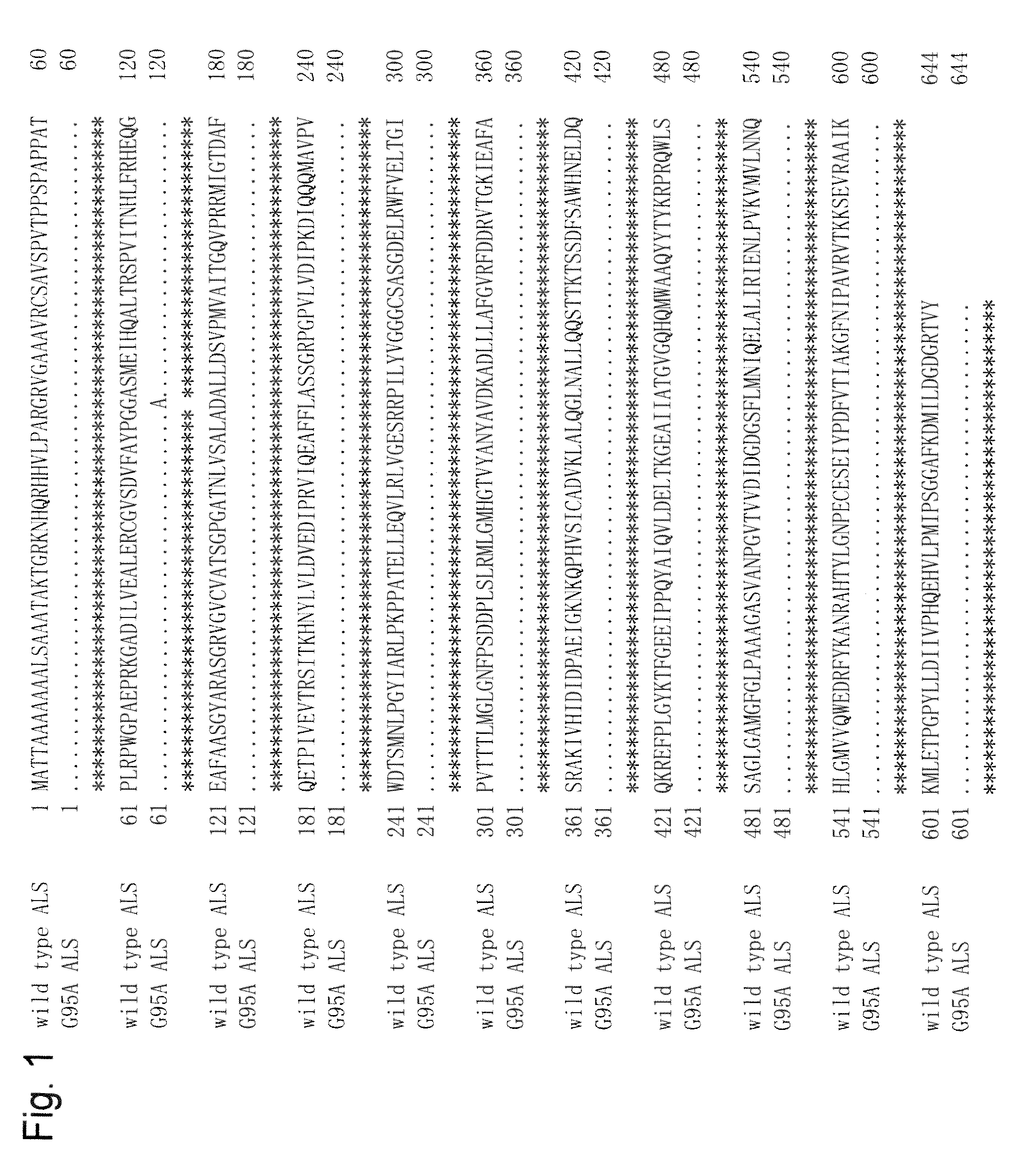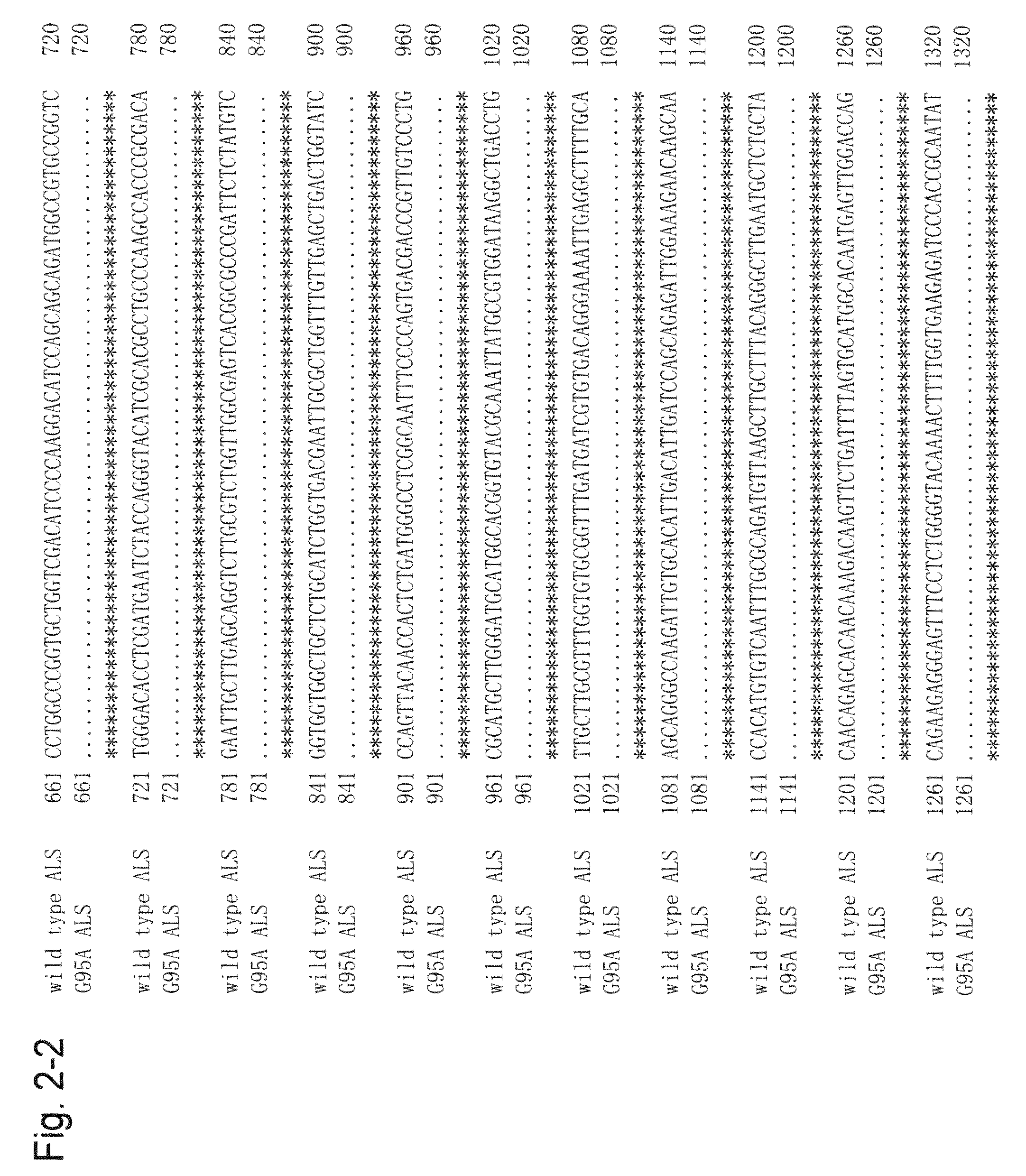Method for transformation using mutant acetolactate synthase gene
a technology of acetolactate synthase and mutant gene, which is applied in the field of transformation and cultivation method of plant using mutant acetolactate synthase, can solve the problem that no case has been reported to date concerning mutant als gene, and achieve the effect of high specificity to pc herbicides and efficient selection of transformed cells
- Summary
- Abstract
- Description
- Claims
- Application Information
AI Technical Summary
Benefits of technology
Problems solved by technology
Method used
Image
Examples
example 1
Callus (Derived from Anther Culture) Induction
[0073]Young panicles having an auricle-to-auricle length ranging from 6 cm to 8 cm were collected, so that the maximum number of anthers at the mononuclear phase could be obtained from “Taichung 65 (a japonica rice cultivar)” in the booting stage. At such time, portions of the stems below the nodes of the prophylls of cotyledons were cut n water. Leaves other than two leaf types (a cotyledon and a prophyll thereof), which directly enwrap each young panicle, were removed.
[0074]The base portions of the stems were wrapped with paper towels soaked with water and then covered with vinyl bags, so that low temperature treatment was performed for 5 to 10 days under dark conditions at 10° C. Subsequently, the young panicles were removed within a clean bench, sterilized with 70% ethanol for 10 minutes, and then dried on sterilized kimtowels (Crecia, Tokyo). Semitransparent glumaceous flowers containing anthers at the mononuclear phase were opened ...
example 2
Selection of Callus (Derived from Anther Culture) Using Bispyribac-Sodium
[0076]Calli (derived from anther culture) in 5 weeks after callus induction were cultured on callus induction medium containing 0.25 μM bispyribac-sodium for 4 weeks. Next, the grown calli were cultured on redifferentiation medium (Table 2) containing 0.5 μM bispyribac-sodium for 4 weeks. Thus, redifferentiated albino plants were obtained. Subculture was performed every 2 weeks in all cases.
[0077]
TABLE 2Redifferentiated medium (pH 5.8)MS inorganic saltN6 vitaminSucrose30g / lSorbitol50g / l2.4-D2mg / lNAA1mg / lBAP2mg / lCasamino acids2g / lL(−)-proline2.878g / lGelrite4g / l
The medium was adjusted to have a total volume of 1 liter, autoclaved, and then supplemented with bispyribac-sodium.
example 3
Bispyribac-Sodium Resistance Test
[0078]The two lines of plants selected by the above method were designated the G95A-1 line and the G95A-2 line. Since they were albino plants, they were cultured on MS medium and then multiplied by division. To test the degree of resistance to bispyribac-sodium, clone plants divided from the G95A-1 line were transplanted on rooting media (Table 3) containing 0 μM, 1 μM, 5 μM, 10 μM, or 20 μM bispyribac-sodium (FIG. 3A: on the left in each Petri dish, observed as white because they were albino). Clone plants of the G95A-2 line (the number of these clone plants is a few) were tested using 5 μM bispyribac-sodium alone. Plants of wild-type Taichung 65 in 2 weeks after seeding were used as members of a control group (FIG. 3, on the right side in each Petri dish). Plant in 1 week (FIG. 3B) after transplantation and plant in 2 weeks (FIG. 3C) after transplantation were observed. As a result, the plants of both the G95A-1 and the G95A-2 lines exerted resista...
PUM
| Property | Measurement | Unit |
|---|---|---|
| length | aaaaa | aaaaa |
| temperature | aaaaa | aaaaa |
| total volume | aaaaa | aaaaa |
Abstract
Description
Claims
Application Information
 Login to View More
Login to View More - R&D
- Intellectual Property
- Life Sciences
- Materials
- Tech Scout
- Unparalleled Data Quality
- Higher Quality Content
- 60% Fewer Hallucinations
Browse by: Latest US Patents, China's latest patents, Technical Efficacy Thesaurus, Application Domain, Technology Topic, Popular Technical Reports.
© 2025 PatSnap. All rights reserved.Legal|Privacy policy|Modern Slavery Act Transparency Statement|Sitemap|About US| Contact US: help@patsnap.com



